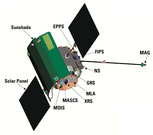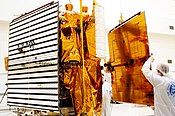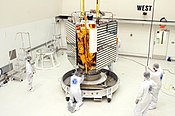
A | B | C | D | E | F | G | H | CH | I | J | K | L | M | N | O | P | Q | R | S | T | U | V | W | X | Y | Z | 0 | 1 | 2 | 3 | 4 | 5 | 6 | 7 | 8 | 9
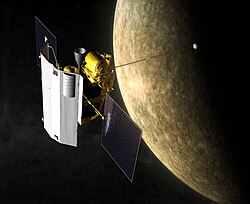 Artist's rendering of MESSENGER orbiting Mercury | |
| Mission type | Mercury probe |
|---|---|
| Operator | NASA |
| COSPAR ID | 2004-030A |
| SATCAT no. | 28391 |
| Website | messenger |
| Mission duration | Total: 10 years, 8 months and 27 days At Mercury: 4 years, 1 month and 14 days En route: 7 years Primary mission: 1 year First extension: 1 year[1][2] Second extension: 2 years[3][4] |
| Spacecraft properties | |
| Manufacturer | Applied Physics Laboratory |
| Launch mass | 1,107.9 kg (2,443 lb)[5] |
| Power | 450 watts |
| Start of mission | |
| Launch date | August 3, 2004, 06:15:56 UTC |
| Rocket | Delta II 7925H-9.5 |
| Launch site | Cape Canaveral SLC-17B |
| Entered service | April 4, 2011 |
| End of mission | |
| Disposal | Crashed into Mercury |
| Destroyed | April 30, 2015 at 19:26 UT[6] |
| Orbital parameters | |
| Reference system | Hermiocentric |
| Perihermion altitude | 200 kilometers (120 mi) |
| Apohermion altitude | 10,300 kilometers (6,400 mi) |
| Inclination | 80 degrees |
| Period | 12 hours |
| Epoch | January 1, 2000[7] |
| Flyby of Earth (gravity assist) | |
| Closest approach | August 2, 2005 |
| Distance | 2,347 kilometers (1,458 mi) |
| Flyby of Venus (gravity assist) | |
| Closest approach | October 24, 2006 |
| Distance | 2,990 kilometers (1,860 mi) |
| Flyby of Venus (gravity assist) | |
| Closest approach | June 5, 2007 |
| Distance | 337 kilometers (209 mi) |
| Flyby of Mercury | |
| Closest approach | January 14, 2008 |
| Distance | 200 kilometers (120 mi) |
| Flyby of Mercury | |
| Closest approach | October 6, 2008 |
| Distance | 200 kilometers (120 mi) |
| Flyby of Mercury | |
| Closest approach | September 29, 2009 |
| Distance | 228 kilometers (142 mi) |
| Mercury orbiter | |
| Orbital insertion | March 18, 2011, 01:00 UTC[8] |
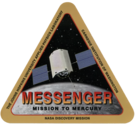
| |
MESSENGER was a NASA robotic space probe that orbited the planet Mercury between 2011 and 2015, studying Mercury's chemical composition, geology, and magnetic field.[9][10] The name is a backronym for "Mercury Surface, Space Environment, Geochemistry, and Ranging", and a reference to the messenger god Mercury from Roman mythology.
MESSENGER was launched aboard a Delta II rocket in August 2004. Its path involved a complex series of flybys – the spacecraft flew by Earth once, Venus twice, and Mercury itself three times, allowing it to decelerate relative to Mercury using minimal fuel. During its first flyby of Mercury in January 2008, MESSENGER became the second mission, after Mariner 10 in 1975, to reach Mercury.[11][12][13]
MESSENGER entered orbit around Mercury on March 18, 2011, becoming the first spacecraft to do so.[9] It successfully completed its primary mission in 2012.[2] Following two mission extensions, the spacecraft used the last of its maneuvering propellant to deorbit, impacting the surface of Mercury on April 30, 2015.[14]
Mission overview
MESSENGER's formal data collection mission began on April 4, 2011.[15] The primary mission was completed on March 17, 2012, having collected close to 100,000 images.[16] MESSENGER achieved 100% mapping of Mercury on March 6, 2013, and completed its first year-long extended mission on March 17, 2013.[2] The probe's second extended mission lasted for over two years, but as its low orbit degraded, it required reboosts to avoid impact. It conducted its final reboost burns on October 24, 2014, and January 21, 2015, before crashing into Mercury on April 30, 2015.[17][18][19]
During its stay in Mercury orbit, the probe's instruments yielded significant data, including a characterization of Mercury's magnetic field[20] and the discovery of water ice at the planet's north pole,[21][22] which had long been suspected on the basis of Earth-based radar data.[23]
Mission background
Previous missions
In 1973, Mariner 10 was launched by NASA to make multiple flyby encounters of Venus and Mercury. Mariner 10 provided the first detailed data of Mercury, mapping 40–45% of the surface.[24] Mariner 10's final flyby of Mercury occurred on March 16, 1975. No subsequent close-range observations of the planet would take place for more than 30 years.
Proposals for the mission
In 1998, a study detailed a proposed mission to send an orbiting spacecraft to Mercury, as the planet was at that point the least-explored of the inner planets. In the years following the Mariner 10 mission, subsequent mission proposals to revisit Mercury had appeared too costly, requiring large quantities of propellant and a heavy lift launch vehicle. Moreover, inserting a spacecraft into orbit around Mercury is difficult, because a probe approaching on a direct path from Earth would be accelerated by the Sun's gravity and pass Mercury far too quickly to orbit it. However, using a trajectory designed by Chen-wan Yen[25] in 1985, the study showed it was possible to execute a Discovery-class mission by using multiple, consecutive gravity assist, 'swingby' maneuvers around Venus and Mercury, in combination with minor propulsive trajectory corrections, to gradually slow the spacecraft and thereby minimize propellant needs.[26]
Objectives
The MESSENGER mission was designed to study the characteristics and environment of Mercury from orbit. The scientific objectives of the mission were:[27][28]
- to characterize the chemical composition of Mercury's surface.
- to study the planet's geologic history.
- to elucidate the nature of the global magnetic field (magnetosphere).
- to determine the size and state of the core.
- to determine the volatile inventory at the poles.
- to study the nature of Mercury's exosphere.
Spacecraft design

The MESSENGER spacecraft was designed and built at the Johns Hopkins University Applied Physics Laboratory. Science operations were managed by Sean Solomon as principal investigator, and mission operations were also conducted at JHU/APL.[29] The MESSENGER bus measured 1.85 meters (73 in) tall, 1.42 m (56 in) wide, and 1.27 m (50 in) deep. The bus was primarily constructed with four graphite fiber / cyanate ester composite panels that supported the propellant tanks, the large velocity adjust (LVA) thruster, attitude monitors and correction thrusters, the antennas, the instrument pallet, and a large ceramic-cloth sunshade, measuring 2.5 m (8.2 ft) tall and 2 m (6.6 ft) wide, for passive thermal control.[29] At launch, the spacecraft weighed approximately 1,100 kilograms (2,400 lb) with its full load of propellant.[30] MESSENGER's total mission cost, including the cost of the spacecraft's construction, was estimated at under US$450 million.[31]
Attitude control and propulsion
Main propulsion was provided by the 645 N, 317 sec. Isp bipropellant (hydrazine and nitrogen tetroxide) large velocity assist (LVA) thruster. The model used was the LEROS 1b, developed and manufactured at AMPAC‐ISP's Westcott works, in the United Kingdom. The spacecraft was designed to carry 607.8 kilograms (1,340 lb) of propellant and helium pressurizer for the LVA.[29]
Four 22 N (4.9 lbf) monopropellant thrusters provided spacecraft steering during main thruster burns, and twelve 4.4 N (1.0 lbf) monopropellant thrusters were used for attitude control. For precision attitude control, a reaction wheel attitude control system was also included.[29] Information for attitude control was provided by star trackers, an inertial measurement unit and six Sun sensors.[29]
Communications
The probe included two small deep space transponders for communications with the Deep Space Network and three kinds of antennas: a high gain phased array whose main beam could be electronically steered in one plane, a medium-gain "fan-beam" antenna and a low gain horn with a broad pattern. The high gain antenna was used as transmit-only at 8.4 GHz, the medium-gain and low gain antennas transmit at 8.4 GHz and receive at 7.2 GHz, and all three antennas operate with right-hand circularly polarized (RHCP) radiation. One of each of these antennas was mounted on the front of the probe facing the Sun, and one of each was mounted to the back of the probe facing away from the Sun.[32]
Power
The space probe was powered by a two-panel gallium arsenide/germanium solar array providing an average of 450 watts while in Mercury orbit. Each panel was rotatable and included optical solar reflectors to balance the temperature of the array. Power was stored in a common-pressure-vessel, 23-ampere-hour nickel–hydrogen battery, with 11 vessels and two cells per vessel.[29]
Computer and software
The spacecraft's onboard computer system was contained in an Integrated Electronics Module (IEM), a device that combined core avionics into a single box. The computer featured two radiation-hardened IBM RAD6000s, a 25 megahertz main processor, and a 10 MHz fault protection processor. For redundancy, the spacecraft carried a pair of identical IEMs. For data storage, the spacecraft carried two solid-state recorders able to store up to one gigabyte each. The IBM RAD6000 main processor collected, compressed, and stored data from MESSENGER's instruments for later playback to Earth.[29]
MESSENGER used a software suite called SciBox to simulate its orbit and instruments, in order to "choreograph the complicated process of maximizing the scientific return from the mission and minimizing conflicts between instrument observations, while at the same time meeting all spacecraft constraints on pointing, data downlink rates, and onboard data storage capacity."[33]
Scientific instruments
Mercury Dual Imaging System (MDIS)

Included two CCD cameras, a narrow-angle camera (NAC) and a wide-angle camera (WAC) mounted to a pivoting platform. The camera system provided a complete map of the surface of Mercury at a resolution of 250 meters/pixel (820 ft/pixel), and images of regions of geologic interest at 20–50 meters/pixel (66–164 ft/pixel). Color imaging was possible only with the narrow-band filter wheel attached to the wide-angle camera.[34][35]
Objectives:[34]
- Flyby Phase:
- Acquisition of near-global coverage at ≈500 meters/pixel (1,600 ft/pixel).
- Multispectral mapping at ≈2 kilometers/pixel (1.2 mi/pixel).
- Orbital Phase:
- A nadir-looking monochrome global photomosaic at moderate solar incidence angles (55°–75°) and 250 meters/pixel (820 ft/pixel) or better sampling resolution.
- A 25°-off-nadir mosaic to complement the nadir-looking mosaic for global stereo mapping.
- Completion of the multispectral mapping begun during the flybys.
- High-resolution (20–50 meters/pixel (66–164 ft/pixel)) image strips across features representative of major geologic units and structures.
| Filters[36] | ||||||||||||||||||||||||||||||||||||||||
|---|---|---|---|---|---|---|---|---|---|---|---|---|---|---|---|---|---|---|---|---|---|---|---|---|---|---|---|---|---|---|---|---|---|---|---|---|---|---|---|---|
| ||||||||||||||||||||||||||||||||||||||||
- Principal investigator: Scott Murchie / Johns Hopkins University
- Data: PDS/MODE narrow-angle catalog, PDS/MODE wide-angle catalog, PDS/PIN data catalog
Gamma-Ray Spectrometer (GRS)
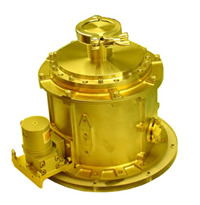
Measured gamma-ray emissions from the surface of Mercury to determine the planet's composition by detecting certain elements (oxygen, silicon, sulfur, iron, hydrogen, potassium, thorium, uranium) to a depth of 10 cm.[37][38]
Objectives:[37]
- Provide surface abundances of major elements.
- Provide surface abundances of Fe, Si, and K, infer alkali depletion from K abundances, and provide abundance limits on H (water ice) and S (if present) at the poles.
- Map surface element abundances where possible, and otherwise provide surface-averaged abundances or establish upper limits.
- Principal investigator: William Boynton / University of Arizona
- Data: PDS/GSN data catalog, PDS/MODE GRS data catalog
Neutron Spectrometer (NS)
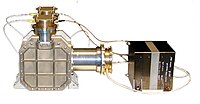
Determined the hydrogen mineral composition to a depth of 40 cm by detecting low-energy neutrons resulting from the collision of cosmic rays with the minerals.[37][38]
Objectives:[37]
- Establish and map the abundance of hydrogen over most of the northern hemisphere of Mercury.
- Investigate the possible presence of water ice within and near permanently shaded craters near the north pole.
- Provide secondary evidence to aid in interpreting GRS measured gamma-ray line strengths in terms of elemental abundances.
- Outline surface domains at the base of both northern and southern cusps of the magnetosphere where the solar wind can implant hydrogen in surface material.
- Principal investigator: William Boynton / University of Arizona
- Data: PDS/GSN data catalog, PDS/MODE NS data catalog
X-Ray Spectrometer (XRS)
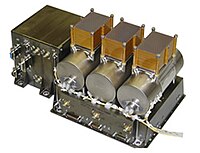
Mapped mineral composition within the top millimeter of the surface on Mercury by detecting X-ray spectral lines from magnesium, aluminum, sulphur, calcium, titanium, and iron, in the 1–10 keV range.[39][40]
Objectives:[39]
- Determine the history of the formation of Mercury
- Characterize the composition of surface elements by measuring the X-ray emissions induced by the incident solar flux.
- Principal investigator: George Ho / APL
- Data: PDS/GSN data catalog, PDS/MODE data catalog
Magnetometer (MAG)

Measured the magnetic field around Mercury in detail to determine the strength and average position of the field.[41][42]
Objectives:[41]
- Investigate the structure of Mercury's magnetic field and its interaction with the solar wind.
- Characterize the geometry and time variability of the magnetospheric field.
- Detect wave-particle interactions with the magnetosphere.
- Observe magnetotail dynamics, including phenomena possibly analogous to substorms in the Earth's magnetosphere.
- Characterize the magnetopause structure and dynamics.
- Characterize field-aligned currents that link the planet with the magnetosphere.
- Principal investigator: Mario Acuna / NASA Goddard Space Flight Center
- Data: PDS/PPI data catalog
Mercury Laser Altimeter (MLA)

Provided detailed information regarding the height of landforms on the surface of Mercury by detecting the light of an infrared laser as the light bounced off the surface. [43][44]
Objectives:[43]
- Provide a high-precision topographic map of the high northern latitude regions.
- Measure the long-wavelength topographic features at mid-to-low northern latitudes.
- Determine topographic profiles across major geologic features in the northern hemisphere.
- Detect and quantify the planet's forced physical librations by tracking the motion of large-scale topographic features as a function of time.
- Measure the surface reflectivity of Mercury at the MLA operating wavelength of 1,064 nanometers.
- Principal investigator: David Smith / GSFC
- Data: PDS/GSN data catalog, PDS/MODE data catalog
Mercury Atmospheric and Surface Composition Spectrometer (MASCS)
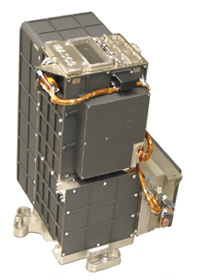
Determined the characteristics of the tenuous atmosphere surrounding Mercury by measuring ultraviolet light emissions, and ascertained the prevalence of iron and titanium minerals on the surface by measuring the reflectance of infrared light.[45][46]
Objectives:[45]
- Characterize the composition, structure, and temporal behavior of the exosphere.
- Investigate the processes that generate and maintain the exosphere.
- Determine the relationship between exospheric and surface composition.
- Search for polar deposits of volatile material, and determine how are the accumulation of these deposits are related to exospheric processes.
- Principal investigator: William McClintock / University of Colorado[47]
- Data: PDS/GSN data catalog, PDS/MODE data catalog
Energetic Particle and Plasma Spectrometer (EPPS)
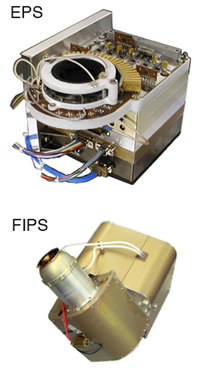
Measured the charged particles in the magnetosphere around Mercury using an energetic particle spectrometer (EPS) and the charged particles that come from the surface using a fast imaging plasma spectrometer (FIPS).[48][49]
Objectives:[48]
- Determine the structure of the planet's magnetic field.
- Characterize exosphere neutrals and accelerated magnetospheric ions.
- Determine the composition of the radar-reflective materialmaterials gyms at Mercury's poles.
- Determine the electrical properties of the crust/atmosphere/environment interface.
- Determine characteristics of the dynamics of Mercury's magnetosphere and their relationships to external drivers and their internal conditions.
- Measure interplanetary plasma properties in cruise and in Mercury vicinity.
- Principal investigator: Barry Mauk / APL
- Data: PDS/PPI data catalog
Radio Science (RS)
Measured the gravity of Mercury and the state of the planetary core by utilizing the spacecraft's positioning data.[50][51]
Objectives:[51]
- Determine the position of the spacecraft during both the cruise and orbital phases of the mission.
- Observe gravitational perturbations from Mercury to investigate the spatial variations of density within the planet's interior, and a time-varying component in Mercury's gravity to quantify the amplitude of Mercury's libration.
- Provide precise measurements of the range of the MESSENGER spacecraft to the surface of Mercury for determining proper altitude mapping with the MLA.
- Principal investigator: David Smith / NASA Goddard Space Flight Center
- Data: PDS/GSN data catalog, PDS/MODE data catalog
- Images of the spacecraft
-
Diagram of MESSENGER.
-
The assembly of MESSENGER's solar panels by APL technicians.
-
Technicians prepare MESSENGER for transfer to a hazardous processing facility.
-
Attachment of the PAM to MESSENGER. The ceramic-cloth sunshade is prominent in this view.
-
A suited worker looks over the hydrazine fuel supply to be loaded in MESSENGER.
Mission profile
| Timeline of key events[2][52][53][54][55][56][57] | ||||||||||||||||||||||||||||||||||||||||||||||||||||||||||||||||||||||||||||||||||||||||||||||||
|---|---|---|---|---|---|---|---|---|---|---|---|---|---|---|---|---|---|---|---|---|---|---|---|---|---|---|---|---|---|---|---|---|---|---|---|---|---|---|---|---|---|---|---|---|---|---|---|---|---|---|---|---|---|---|---|---|---|---|---|---|---|---|---|---|---|---|---|---|---|---|---|---|---|---|---|---|---|---|---|---|---|---|---|---|---|---|---|---|---|---|---|---|---|---|---|---|
| ||||||||||||||||||||||||||||||||||||||||||||||||||||||||||||||||||||||||||||||||||||||||||||||||

